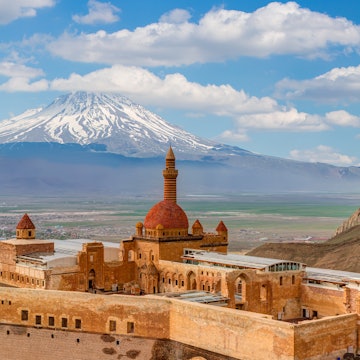

Traffic crossing over the Golden Horn, an inlet of the Bosphorus in Istanbul. Phil Weymouth/Lonely Planet
Türkiye is a country that connects two continents, covering an immense geography. This vastness makes it a fascinating destination. While road transport accounts for the overwhelming majority of passenger traffic in Türkiye in recent years, high-speed train lines and the expansion of domestic flights have fundamentally changed the way people travel.
Major metropolises – especially Istanbul, Ankara and Izmir – are highly navigable thanks to their extensive rail and public transportation networks. However, travelers wishing to experience Türkiye’s full geography must combine walking and public transportation for short distances, and use buses, trains or planes for intercity travel. Given the scale of Turkish cities, relying solely on walking is nearly impossible. Türkiye’s transportation infrastructure is designed in a way that can give visitors confidence in exploring the country; the real key lies in choosing the right mode of transport at the right time. This guide provides all the practical information you need to make moving around Türkiye easier and your journey more enjoyable.

Use the tram and metro to avoid traffic
Türkiye’s travel modes range from urban mobility to rapid cross-country connections. Each comes with its own advantages and disadvantages. The most efficient and sustainable way to bypass the heavy traffic of the country's big cities is rail transport. Mega projects such as Istanbul’s Marmaray and Metrobus, Ankara’s metro lines and Izmir’s light rail system allow travelers to move quickly and economically.
In Istanbul, Izmir and Ankara, underground transport helps visitors avoid rush-hour traffic and reduce their carbon footprint. These networks provide easy access to tourist sites, business centers and accommodation areas. New stations are modern and well-signposted, with Turkish and English directions. Tram lines often run above ground, offering city views and convenient access to historic districts.
Consider domestic flights to save time
While land transport is the backbone of Turkish travel, the vast distances between its major cities and tourist regions often make domestic flights the most time-efficient choice. Türkiye has invested heavily in its aviation infrastructure, and the result is an extensive network of modern airports and frequent flights.
For journeys spanning the country—such as from Istanbul to the resort city of Antalya, the historical sites in Cappadocia, or the eastern city of Kars—flying is often the fastest and most comfortable option.
Carriers like Turkish Airlines and Pegasus Airlines connect dozens of cities, providing easy access even to smaller regional hubs. A trip that could take 10 to 15 hours by bus or high-speed train is often reduced to just a one-hour flight. Thanks to strong competition, domestic flight tickets can sometimes be surprisingly affordable, especially when booked in advance, making them a competitive alternative to sleeper buses for long distances. If your itinerary is tightly packed or you're looking to minimize travel time between distant points of interest, consider an intercity flight as a practical solution.

For a cultural experience, take ferries and boats
In cities like Istanbul, where the Bosphorus runs through the heart of the city, water transport is not just a means of travel but also a distinct cultural experience.
Ferries and sea buses provide fast and scenic connections between the European and Asian sides of Istanbul. As you cross from Kadıköy to Eminönü or from Beşiktaş to Üsküdar, you’ll have the chance to view historic landmarks, mosques and waterfront mansions. These journeys are far more relaxing than traveling by bus or metro. Pair the trip with tea and a sesame bagel (simit) from the onboard cafés, and you’ll enjoy a quintessential Istanbul ritual. All water transport in Istanbul accepts the Istanbulkart.

Buses and high-speed trains are best for long distances
For covering long distances within the country, two main modes of land transport stand out: buses and high-speed trains (YHT).
Türkiye’s bus network is comprehensive. It connects every major city and almost every small district. Numerous private bus companies operate modern, air-conditioned and comfortable buses around the clock. This makes buses the best choice for budget travelers or for destinations not covered by train routes. However, given the dominance of road transport in Türkiye, delays on long bus journeys are common.
YHT, on the other hand, offers a much faster and more comfortable alternative to buses along major routes such as Ankara–Istanbul, Ankara–Eskişehir, Ankara–Konya, and Ankara–Sivas. Sometimes even more affordable than bus tickets, YHT trains stop at stations close to city centers, saving time. The expansion of YHT lines marks an important step in boosting sustainable transport. Tickets should be booked in advance – especially during peak seasons – via the official TCDD website or mobile app.
Ride-sharing apps guarantee fair pricing and direct routes
Yellow taxis remain common throughout Türkiye, but the best way for travelers to ensure fair pricing and direct routes is to use official ride-hailing applications. In major cities like Istanbul, Ankara and Izmir, apps such as Bitaksi and the municipality’s official iTaksi have become essential tools for locals and visitors.
These platforms allow you to book a registered yellow taxi directly from your smartphone, eliminating the need to hail one on a busy street. The key benefit is price transparency: the app provides an estimated fare range upfront, uses GPS for tracking, and accepts both cash and secure digital payments (credit card via the app). This process effectively eliminates any haggling and minimizes misunderstandings about directions, as the destination is entered directly into the system.
You can use these applications with both standard yellow taxis and the slightly more comfortable, and often cleaner, turquoise or black luxury taxis. Using a ride-hailing app is a more relaxed and reliable option, particularly during rush hours.

Taxi stands are best in smaller cities and towns
In smaller cities and towns – for example, Çanakkale, Amasra or Bodrum – there is no need to rely solely on apps. Travelers can easily use local taxi stands to reach destinations quickly and conveniently. This makes it simple to access city centers and popular tourist spots such as the Ancient City of Troy, the Gallipoli or Bodrum Castle.
Use the dolmuş for shorter trips not covered by the metro
For shorter trips or routes not covered by the metro, the dolmuş (which means "stuffed" or "full") is a quintessential Turkish transport experience that every visitor should try.
A dolmuş is a shared minivan or large taxi that operates along a fixed route, similar to a bus, but without scheduled stops. They are faster than buses because they only move once they are full (or nearly full). A Dolmuş can be hailed anywhere along its designated route and will drop you off exactly where you need to be.
Used heavily by locals for crossing neighborhoods, the dolmuş is a fast, economical, and highly social way to travel short to medium distances. Just be aware that they operate on a cash-only basis, and you will typically pass your fare forward to the driver or the person seated next to them. Always keep a few small denomination notes (5–20 Turkish lira) with you because drivers often do not carry a lot of change. Having the exact fare ready makes the process quicker for everyone.

Integrated ticketing systems are the keys to public transport in major cities
The most important component of modern public transport in Türkiye’s major cities is the integrated ticketing system.
Istanbulkart
Istanbul's prepaid card works across all municipal services (metro, tram, bus, Metrobus, ferry, and Marmaray). Cards can be purchased from kiosks, vending machines or ticket machines at metro stations, and money can be added easily.
Tips: If you are staying in Istanbul for more than a few days, it is a good idea to register your Istanbulkart online to protect your balance in case it is lost. Always keep a small balance on the card to avoid problems during rush hours. Tourists can use anonymous cards, but personalized cards offer extra features and security. One Istanbulkart can be used for multiple people, although transfer discounts only apply to the first user.
AntalyaKart
AntalyaKart is necessary for buses and trams across Antalya.
Tips: Tourists can easily buy and load AntalyaKarts at the airport or main bus terminals. The mobile app also allows QR-code boarding, which is convenient for short-term visitors. When traveling to beach areas, check tram and bus schedules to ensure smooth connections. It is a good idea to load extra money before heading to more distant neighborhoods.

İzmirim Kart
The İzmirim Kart can be used on buses, ferries, metro, trams, and İZBAN suburban trains in İzmir.
Tips: Take advantage of İzmir’s 90-minute transfer rule, which allows multiple rides on a single fare. Downloading the mobile app will make QR-code boarding and balance top-ups much faster. The card can also be used at some cultural venues and municipal services, which adds convenience. Always keep extra balance during peak ferry or tram times to avoid delays.
BursaKart
Bursa’s BursaKart works on BursaRay, buses and trams.
Tips: Monthly subscriptions are a good choice for frequent riders as they provide savings. Using the mobile app, you can manage balances for multiple cards. Night transport services accept the BursaKart, but it is important to check the last departure times. Loading your card before leaving central districts can save time at busy machines.

Ankarakart
Ankara’s Ankarakart is valid on metro, Ankaray and EGO buses. Cards are available for adults, students and seniors.
Tips: Students should carry a valid ID when using a discounted card, as verification may be required. Registered Ankarakarts allow balance recovery if the card is lost. Since vending machines may not be available in all neighborhoods, it is wise to check your balance and reload before traveling far. Having a backup payment method is also recommended in case machines are busy.
Konyakart
Konyakart is used on city buses and trams in Konya.
Tips: Konyakart is affordable and simple to reload at numerous points across the city. Students should look for available discounted versions. Always check your card balance before boarding to avoid being stopped. During peak hours, vending machines can be crowded, so planning ahead for top-ups is helpful.
Frequently asked questions
Are Uber and other ride-sharing services available in Türkiye?
Yes, but mostly through taxis. Due to regulations, Uber in Türkiye operates only with licensed yellow taxis. The app allows you to book a regular taxi and pay through the platform. Services like UberX with private cars are not widely available. Therefore, local apps like BiTaksi or iTaksi are the most practical alternatives.
Does a transport card work on both metro and bus?
Absolutely yes. In major cities such as Istanbul, Ankara and Izmir, a single electronic card (Istanbulkart in Istanbul, Ankarakart in Ankara and Izmirim Kart in Izmir) covers most public transport types, including buses, metro, tram, cable car, certain ferry lines and commuter trains. This integration is one of the greatest conveniences for travelers.
Accessible transportation in Türkiye
Türkiye has made significant progress in improving accessibility under the UN Convention on the Rights of Persons with Disabilities. Public transport vehicles and infrastructure are increasingly designed to make travel easier for people with disabilities or limited mobility.

What to know for travelers with reduced mobility
Accessibility is excellent in newly built projects and renovated public transport vehicles, though older infrastructure may still present challenges.
Rail systems: Most new metro and tram stations in Istanbul, Ankara, and Izmir are equipped with elevators, ramps, and Braille signage. YHT trains feature designated areas and restrooms for passengers with disabilities. Train stations (gar) also offer adjustable platforms for wheelchair access.
City buses: Most metropolitan buses are low-floor and ramp-equipped for wheelchair users.
Airports: Türkiye’s major and newly built airports meet international standards with dedicated parking, accessible restrooms, and wheelchair services. Notifying your airline of any special needs before your flight ensures a smoother experience.
Accessibility challenges: Uneven sidewalks in historic districts, older bus stops, and under-equipped rural transport can pose obstacles. In such cases, the hospitality and helpfulness of locals often make up for shortcomings.
















